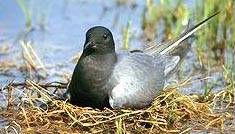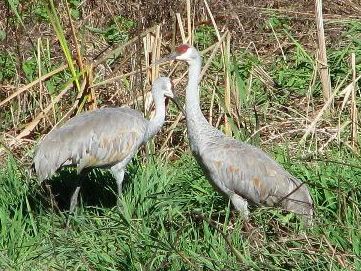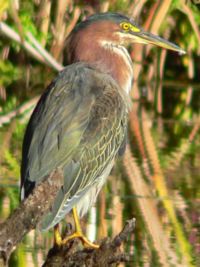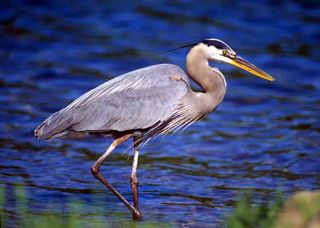Historical Background
Prior to the turn of the 20th century, the area before you was a
floodplain.
 Black Tern
Black Tern
That means that when the Fox River got high, this area took excess
water - it flooded. Around 1900, settlers decided that this
floodplain would make good farmland if only they could keep it from
flooding. So they built a system of levees around and within the
floodplain to manage the floodwaters and to allow farming. The area
was farmed for several decades, likely until the 1960's when this
land became the property of the Illinois Department of Natural
Resources (IDNR).
Under IDNR management, the property served as a habitat for many
creatures, some with wings and some without. Around 1990,
representatives from Ducks Unlimited contacted the IDNR about
funding a project somewhere in Northern Illinois. Moraine Hills
State Park has a unique set of conditions for the creation of a
particular kind of wetland that could serve as a breeding area and
a resting area for a number of different threatened and endangered
species of birds. Together, the IDNR and Ducks Unlimited chose
Moraine Hills State Park as the site of a collaborative effort
resulting in the creation of "Black Tern Marsh."
A Special Kind of Marsh
Certain kinds of birds prefer an environment known as "hemi-marsh."
This type of environment has about equal amounts of vegetation and
open water. These hemi-marshes occur naturally but as more land is
developed for housing and industry, these marshes become more rare
due to the impact of development on the natural flow of water over
a landscape. As a result of the loss of hemi-marshes, a number of
species of birds dependent on this kind of habitat have become
threatened and endangered.
 Sandhill Cranes - photo by
geognerd
Sandhill Cranes - photo by
geognerd
Here at Moraine Hills State Park, there exists a unique set of
conditions for creating a hemi-marsh. First, the nearby dam divides
the Fox River in to upper and lower "pools." Second, in close
proximity to these two pools of differing elevations, we have that
floodplain around which the farmers had created the levees. The
third condition making the creation of the marsh possible is the
levees themselves. Those levees created a sort of "bathtub" in
which farmers could cultivate the land to produce crops. Those
farmers who built the bathtub in this floodplain wanted to keep the
water out. But the project planners from IDNR and DU
realized that they could also use the levee system here to keep
water in.
 Green Heron
Green Heron
In 1991, a group of Life Donors from Ducks Unlimited funded an
engineering study to determine the feasability of filling up the
bathtub from water in the upper pool of the Fox River and then
providing a drain for the bathtub into the lower pool of the river.
After determining that this idea was feasible, construction started
on the creation of "The Black Tern Marsh," a hemi-marsh serving
numerous threatened and endangered migratory birds. The cache site
affords an excellent view of the marsh. The construction of the
marsh was a collaborative effort between the Ducks Unlimited and
the IDNR but the funding came entirely from the small group of
Ducks Unlimited donors whose names appear on the nearby plaque.
The project involved installing around 800 feet of 3-foot diameter
pipe underground to connect the upper pool of the Fox river with
the basin of the former floodplain. A second pipe connects the
marsh with the lower pool. A gate valve between the basin and the
lower pool is used to manage the water levels. At other sites along
the Fox, and other rivers, hemi-marshes are created by moving water
with massive diesel-powerered pumps that run twenty-four hours a
day. At this site the water flow is powered by a force much cheaper
and cleaner than pumps: gravity.
Managing the water levels in this marsh is critical to preserving
the ratio of vegetation and open water which makes the marsh a
hemi-marsh. The IDNR has a management plan which responds to
different conditions in the marsh. Part of that plan neccessitates
an annual drawdown of the water level to mimic the naturally
occurring changes essential to the balance of vegetation and open
water unique to hemi-marshes.
The Birds of Black Tern Marsh
The Black
Tern is a summer resident of the marsh. Also, great blue and green herons feed in the marsh during the
summer. It is also possible to see migratory waterfowl such as
Canada Geese and numerous kinds of ducks. In the spring,
sandhill cranes breed here.
 Great Blue Heron
Great Blue Heron
Ducks Unlimited is an organization that promotes waterfowl
habitat throughout North America. In fact, DU does more to protect,
restore and manage habitat than any other private organization in
the world.
Illinois Department of
Natural Resources required statement:
- 1. Geocache is placed on Department-managed property with
permission.
- 2. Do not place the following items in the Geocache:
Food items, inappropriate,
offensive, or hazardous materials.
- 3. It is the visitors' responsibility to orient themselves with
policies
and rules pertaining to this
Department-managed site.
.
.
.
.
.